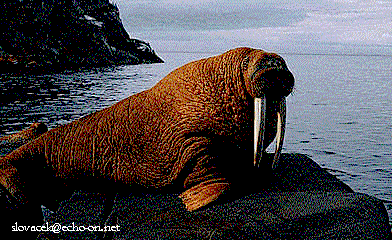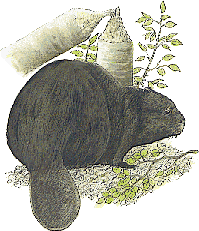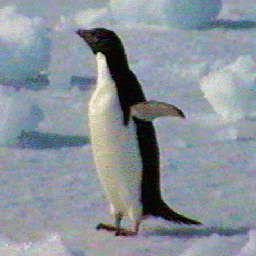
 The Inuit know the walrus as "aivik". Until the 18th century the English name
for the walrus was morse, probably from the Finnish mursu or the Lapp morsk.
The name walrus means "whale-horse."
The Inuit know the walrus as "aivik". Until the 18th century the English name
for the walrus was morse, probably from the Finnish mursu or the Lapp morsk.
The name walrus means "whale-horse."
 The manatee has only one pair of limbs. They are the weak front flippers which
they use to push algae, such as seaweed and other water plants toward their mouths.
The manatee has only one pair of limbs. They are the weak front flippers which
they use to push algae, such as seaweed and other water plants toward their mouths.


 Beaver dams come in all shapes and sizes. Normally a family of
beavers can build a dam 35 feet (10 meters) long in about a week. Some
dams more than 1,000 feet (300 meters) long have been found, but
these are the work of generations of beavers.
Beaver dams come in all shapes and sizes. Normally a family of
beavers can build a dam 35 feet (10 meters) long in about a week. Some
dams more than 1,000 feet (300 meters) long have been found, but
these are the work of generations of beavers.
 Humpback whales swim great lengths during their migrationn routes.
They swim around up to 3000 miles (4800 kilometers!)
Humpback whales swim great lengths during their migrationn routes.
They swim around up to 3000 miles (4800 kilometers!)


 The polar bear is fully covered with long, thick white fur. But it's
skin however is colored black! (It makes sense when you think of it.)
The polar bear is fully covered with long, thick white fur. But it's
skin however is colored black! (It makes sense when you think of it.)
 The sea otter is the only living marine species in the weasel family.
It also sleeps in the water and to avoid from drifting away, they wrap
themselves in seaweed that surfaces near the top of the water!
The sea otter is the only living marine species in the weasel family.
It also sleeps in the water and to avoid from drifting away, they wrap
themselves in seaweed that surfaces near the top of the water!
 Dolphins and porpoises are noted for their intelligence and learning
abilities. Their social behavior and organization are among the most
complex and advanced in the animal kingdom.
Dolphins and porpoises are noted for their intelligence and learning
abilities. Their social behavior and organization are among the most
complex and advanced in the animal kingdom.



 The platypus, also known as the duckbill, watermole, or duckmole, is also
known for laying eggs instead of giving birth to live young as do most mammals.
The male platypus has hollow spurs connected to venom glands on the ankle of each
hind leg.
The platypus, also known as the duckbill, watermole, or duckmole, is also
known for laying eggs instead of giving birth to live young as do most mammals.
The male platypus has hollow spurs connected to venom glands on the ankle of each
hind leg.
 Penguins can swim at speeds of more than 25 miles (40 kilometers) per
hour. When they want to leave the water, they can leap as much as 6
feet (1.8 meters) from the water's surface onto a rock or iceberg.
Adult penguins bite savagely when they are threatened and
show little fear of humans. They may use their wings to batter the
shins of persons who intrude on their nesting grounds!
Penguins can swim at speeds of more than 25 miles (40 kilometers) per
hour. When they want to leave the water, they can leap as much as 6
feet (1.8 meters) from the water's surface onto a rock or iceberg.
Adult penguins bite savagely when they are threatened and
show little fear of humans. They may use their wings to batter the
shins of persons who intrude on their nesting grounds!



Here is some facts about water pollution.
 Since the beginning of civilization, water has been used to carry
away unwanted refuse. Rivers, streams, canals, lakes, and oceans are
currently used as receptacles for every imaginable kind of pollution.
Water has the capacity to break down or dissolve many materials,
especially organic compounds, which decompose during prolonged contact
with bacteria and enzymes. Waste materials that can eventually
decompose in this way are called biodegradable. They are less of a
long-term threat to the environment than are more persistent pollutants
such as metals, plastics, and some chlorinated hydrocarbons. These
substances remain in the water and can make it poisonous for most
forms of life. Even biodegradable pollutants can damage a water supply
for long periods of time. As any form of contamination accumulates,
life within the water starts to suffer. Lakes are especially vulnerable
to pollution because they cannot cleanse themselves as rapidly as
rivers or oceans.
Since the beginning of civilization, water has been used to carry
away unwanted refuse. Rivers, streams, canals, lakes, and oceans are
currently used as receptacles for every imaginable kind of pollution.
Water has the capacity to break down or dissolve many materials,
especially organic compounds, which decompose during prolonged contact
with bacteria and enzymes. Waste materials that can eventually
decompose in this way are called biodegradable. They are less of a
long-term threat to the environment than are more persistent pollutants
such as metals, plastics, and some chlorinated hydrocarbons. These
substances remain in the water and can make it poisonous for most
forms of life. Even biodegradable pollutants can damage a water supply
for long periods of time. As any form of contamination accumulates,
life within the water starts to suffer. Lakes are especially vulnerable
to pollution because they cannot cleanse themselves as rapidly as
rivers or oceans.
 A common kind of water pollution is the effect caused by heavy
concentrations of nitrogen and phosphorus, which are used by plants
for growth. The widespread use of agricultural fertilizers and
household detergents containing these elements has added large amounts
of plant nutrients to many bodies of water. In large quantities,
nitrogen and phosphorus cause tiny water algae to bloom, or grow
rapidly. When the algae die, oxygen is needed to decompose them. This
creates an oxygen deficiency in the water, which causes the death of
many aquatic animals. Plant life soon reduces the amount of open water.
These events speed up the process of eutrophication, the aging and
eventual drying up of a lake.
A common kind of water pollution is the effect caused by heavy
concentrations of nitrogen and phosphorus, which are used by plants
for growth. The widespread use of agricultural fertilizers and
household detergents containing these elements has added large amounts
of plant nutrients to many bodies of water. In large quantities,
nitrogen and phosphorus cause tiny water algae to bloom, or grow
rapidly. When the algae die, oxygen is needed to decompose them. This
creates an oxygen deficiency in the water, which causes the death of
many aquatic animals. Plant life soon reduces the amount of open water.
These events speed up the process of eutrophication, the aging and
eventual drying up of a lake.
 Factories sometimes turn waterways into open sewers by dumping oils,
toxic chemicals, and other harmful industrial wastes into them. In
mining and oil-drilling operations, corrosive acid wastes are poured
into the water. In recent years, municipal waste treatment plants have
been built to contend with water contamination (see Sewage Disposal).
Some towns, however, still foul streams by pouring raw sewage into
them. Septic tanks and cesspools, used where sewers are not available,
may also pollute the groundwater and adjacent streams, sometimes with
disease-causing organisms. Even the purified effluent from sewage
plants can cause water pollution if it contains high concentrations of
nitrogen and phosphorus. Farm fertilizers in some regions fill
groundwater with nitrates, making the water unfit to drink.
Agricultural runoff containing dangerous pesticides and the oil, grime,
and chemicals used to melt ice from city streets also pollute
waterways.
Factories sometimes turn waterways into open sewers by dumping oils,
toxic chemicals, and other harmful industrial wastes into them. In
mining and oil-drilling operations, corrosive acid wastes are poured
into the water. In recent years, municipal waste treatment plants have
been built to contend with water contamination (see Sewage Disposal).
Some towns, however, still foul streams by pouring raw sewage into
them. Septic tanks and cesspools, used where sewers are not available,
may also pollute the groundwater and adjacent streams, sometimes with
disease-causing organisms. Even the purified effluent from sewage
plants can cause water pollution if it contains high concentrations of
nitrogen and phosphorus. Farm fertilizers in some regions fill
groundwater with nitrates, making the water unfit to drink.
Agricultural runoff containing dangerous pesticides and the oil, grime,
and chemicals used to melt ice from city streets also pollute
waterways.
(Information from Compton's Concise Encyclopedia
Copyright {c} 1995 Compton's NewMedia, Inc.)




 [Previous Animals]....[Home]....[Cherry's Woods]
[Previous Animals]....[Home]....[Cherry's Woods]

 slovacek@echo-on.net
slovacek@echo-on.net

 Last Updated 29/9/97
Last Updated 29/9/97 